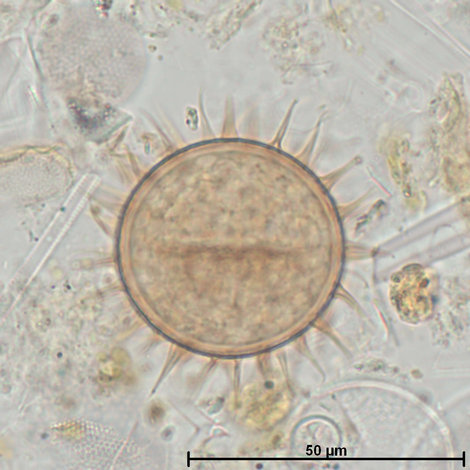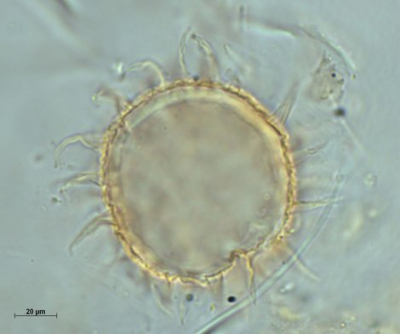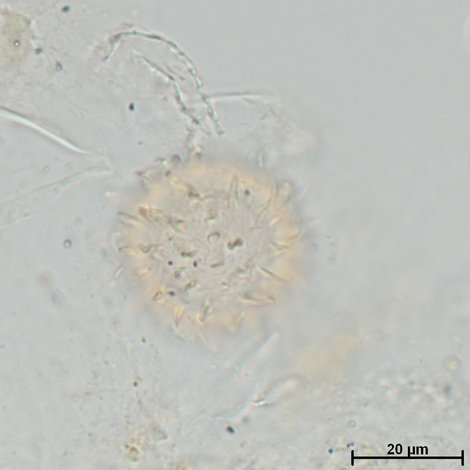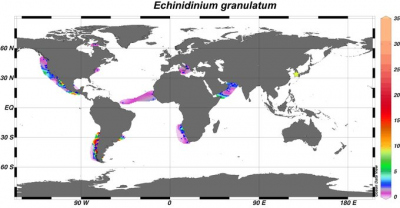Die Inhalte dieser Seite sind leider nicht auf Deutsch verfügbar.
Seitenpfad:
Echinidinium granulatum
Zonneveld, K.A.F. and Pospelova V. (2015). A determination key for modern dinoflagellate cysts. Palynology 39 (3), 387- 409.



cross section Holotype
photo by Karin Zonneveld
photo by Karin Zonneveld
cross section
photo by Karin Zonneveld
lateral view
photograph Karin Zonneveld
Field characteristics
Echinidinium granulatum Zonneveld 1997
Characteristics:
Spheroidal cysts covered with numerous randomly distributed spines. Cyst wall pigmented with a thin pedium and a luxuria of isolated granulae. The hollow spines are formed by separation of the luxuria and pedium. The luxuria of the spines is smooth but fine solid spinules can be present at the distal ends of the spines. Spines are acuminate with closed distal ends. The broad spine bases are (sub) spherical to ovoidal. The chasmic archeopyle consists of a single split along one or two sutures.
Dimensions: Cyst body diameter: 26 to 46 µm; length of processes: 5 to 11 µm.
Motile affinity: Unknown.
Stratigraphic range: late Pleistocene to Recent.
Comparison with other species: T
This species can be distinguished from the others by its hollow processes that are distally closed, the spherical form of the basis of the processes and by its granulate cyst wall. The processes can have small spinules at their distal ends like L. machaerophorum, but this does not have to be the case.
Characteristics:
Spheroidal cysts covered with numerous randomly distributed spines. Cyst wall pigmented with a thin pedium and a luxuria of isolated granulae. The hollow spines are formed by separation of the luxuria and pedium. The luxuria of the spines is smooth but fine solid spinules can be present at the distal ends of the spines. Spines are acuminate with closed distal ends. The broad spine bases are (sub) spherical to ovoidal. The chasmic archeopyle consists of a single split along one or two sutures.
Dimensions: Cyst body diameter: 26 to 46 µm; length of processes: 5 to 11 µm.
Motile affinity: Unknown.
Stratigraphic range: late Pleistocene to Recent.
Comparison with other species: T
This species can be distinguished from the others by its hollow processes that are distally closed, the spherical form of the basis of the processes and by its granulate cyst wall. The processes can have small spinules at their distal ends like L. machaerophorum, but this does not have to be the case.
Geographic distribution
Geographic distribution based on:
Zonneveld et al., 2013. Atlas of modern dinoflagellate cyst distribution based on 2405 datapoints. Review of Palaeobotany and Palynology, v. 191, 1-197
E. granulatum is observed in fully-marine sub-polar to equatorial regions with enhanced primary production in the upper waters. Bottom waters are anoxic/hypoxic as a result of the presence of upwelling or coastal eutrophication.
Zonneveld et al., 2013. Atlas of modern dinoflagellate cyst distribution based on 2405 datapoints. Review of Palaeobotany and Palynology, v. 191, 1-197
E. granulatum is observed in fully-marine sub-polar to equatorial regions with enhanced primary production in the upper waters. Bottom waters are anoxic/hypoxic as a result of the presence of upwelling or coastal eutrophication.

Distribution:
E. granulatum is observed in sub-polar to equatorial coastal regions and upwelling areas of the eastern Pacific, North and South Atlantic Ocean, the central Mediterranean Sea and the Arabian Sea. Highest relative abundances up to 31% are observed in the subtropical and tropical eastern Pacific Ocean and Gulf of California.
Environmental parameter range:
SST: 6.3 - 29.8°C (summer-summer) and SST > 7.9°C in winter. Exception is formed by one site in the Hudson Strait (northwestern North Atlantic) where SST: -1.9, -0.01, 2.0 and 0.5°C (Winter, spring, summer, autumn). SSS: 28.4 - 38.9 (winter - summer), [P]: 0.6 - 1.2 μmol/l, [N]: 0.1 - 13.2 μmol/l, chlorophyll-a: 0.14 - 16.7 ml/l, bottom water [O2]: 0 - 5.3 ml/l.
E. granulatum is absent where SSS is reduced. It is present in an eutrophic environment with mostly anoxic/hypoxic conditions.
Comparison with other records:
Apart from the records in this Atlas, E. granulatum has been documented from unstratified highly polluted waters of South Korean bays (Pospelova and Kim, 2010). In coastal bays of southern Vancouver Island, E. granulatum cysts are most abundant in sediments with high organic matter concentrations (Krepakevich and Pospelova, 2010). Cysts are produced during active upwelling in the Arabian Sea whereas off NW Africa the cyst production is not linked to upwelling (Zonneveld and Brummer, 2000; Zonneveld et al., 2010). Off NW Africa cysts are abundant in traps when the trap sediments contain high Nitrate and total organic matter concentrations. In the Saanich Inlet (BC, Canada) its production can be related to enhanced diatom production (Price and Pospelova, 2011).
E. granulatum is observed in sub-polar to equatorial coastal regions and upwelling areas of the eastern Pacific, North and South Atlantic Ocean, the central Mediterranean Sea and the Arabian Sea. Highest relative abundances up to 31% are observed in the subtropical and tropical eastern Pacific Ocean and Gulf of California.
Environmental parameter range:
SST: 6.3 - 29.8°C (summer-summer) and SST > 7.9°C in winter. Exception is formed by one site in the Hudson Strait (northwestern North Atlantic) where SST: -1.9, -0.01, 2.0 and 0.5°C (Winter, spring, summer, autumn). SSS: 28.4 - 38.9 (winter - summer), [P]: 0.6 - 1.2 μmol/l, [N]: 0.1 - 13.2 μmol/l, chlorophyll-a: 0.14 - 16.7 ml/l, bottom water [O2]: 0 - 5.3 ml/l.
E. granulatum is absent where SSS is reduced. It is present in an eutrophic environment with mostly anoxic/hypoxic conditions.
Comparison with other records:
Apart from the records in this Atlas, E. granulatum has been documented from unstratified highly polluted waters of South Korean bays (Pospelova and Kim, 2010). In coastal bays of southern Vancouver Island, E. granulatum cysts are most abundant in sediments with high organic matter concentrations (Krepakevich and Pospelova, 2010). Cysts are produced during active upwelling in the Arabian Sea whereas off NW Africa the cyst production is not linked to upwelling (Zonneveld and Brummer, 2000; Zonneveld et al., 2010). Off NW Africa cysts are abundant in traps when the trap sediments contain high Nitrate and total organic matter concentrations. In the Saanich Inlet (BC, Canada) its production can be related to enhanced diatom production (Price and Pospelova, 2011).


